Therizinosaurus
Therizinosaurus was a huge herbivorous theropod dinosaur from the end of the Cretaceous period.
| Therizinosaurus Temporal range: Upper Cretaceous
| |
|---|---|

| |
| Conservation status | |
Fossil
| |
| Scientific classification | |
| Kingdom: | |
| Phylum: | |
| Class: | |
| Superorder: | |
| Order: | |
| Suborder: | |
| Infraorder: | |
| Family: | |
| Genus: | Therizinosaurus
|
| Species: | T. cheloniformis
|
| Binomial name | |
| Therizinosaurus cheloniformis Maleev, 1954
| |
New, well-preserved finds such as Alxasaurus in 1993 and Beipiaosaurus in 1996 provided details about the bird-like pelvis, feet and skulls of primitive members. This helped confirm they belonged to the same group of theropod dinosaurs as Therizinosaurus and that therizinosaurs were, more specifically, advanced, herbivorous maniraptoran theropods.
Their fossils were first found in the late 1940s in Asia. They were named in 1954 after more bones were found. It was a thought to be a carnivore and herbivore; it had very long claws - they were about 90 centimetres (3.0 ft) long.
Paleobiology
The feeding habits of Therizinosaurus are unknown, since no skull material has ever been found that could indicate its diet. However, like other therizinosaurs, it was probably primarily herbivorous.[1]
There are multiple possible functions that could have been served by the claws of Therizinosaurus, such as defense against predators (e.g. the contemporary Tarbosaurus) and in intraspecific fighting, such as fighting for territory or for mating, or to pull leafy tree branches towards its mouth. The claws may have served all these functions.
Therizinosaurus Media
Cretaceous fossil localities of Mongolia; Therizinosaurus fossils have been collected from the Altan Uul, Hermiin Tsav, and Nemegt localities at the area A (Nemegt Formation)
Holotype unguals PIN 551–483 at the Moscow Paleontological Museum; note left ungual cast
Arms of specimen MPC-D 100/15 with unguals 100/16 and 100/17 at CosmoCaixa Barcelona
Skeletal diagram featuring the known unguals of Therizinosaurus
References
- ↑ Svarney T.E. and Svarney P.B. 2003. The handy Dinosaur answer book. 1st ed. Canton, MI: Visible Ink Press.








